Management of Post-Operative Complications in Cushing's Syndrome
VerifiedAdded on 2021/04/16
|9
|2447
|46
AI Summary
This assignment provides an in-depth analysis of the nursing care required for a post-operative patient with Cushing's syndrome. The case involves a 40-year-old obese diabetic female who underwent laparoscopic surgery. The nursing care should focus on combating post-operative complications, monitoring vital signs, and managing deranged liver function tests. A multidisciplinary team including a physiotherapist, nutritionist, and social worker is essential for effective patient management. This assignment highlights the importance of early mobilization, nutrition planning, and social support in improving patient outcomes.
Contribute Materials
Your contribution can guide someone’s learning journey. Share your
documents today.
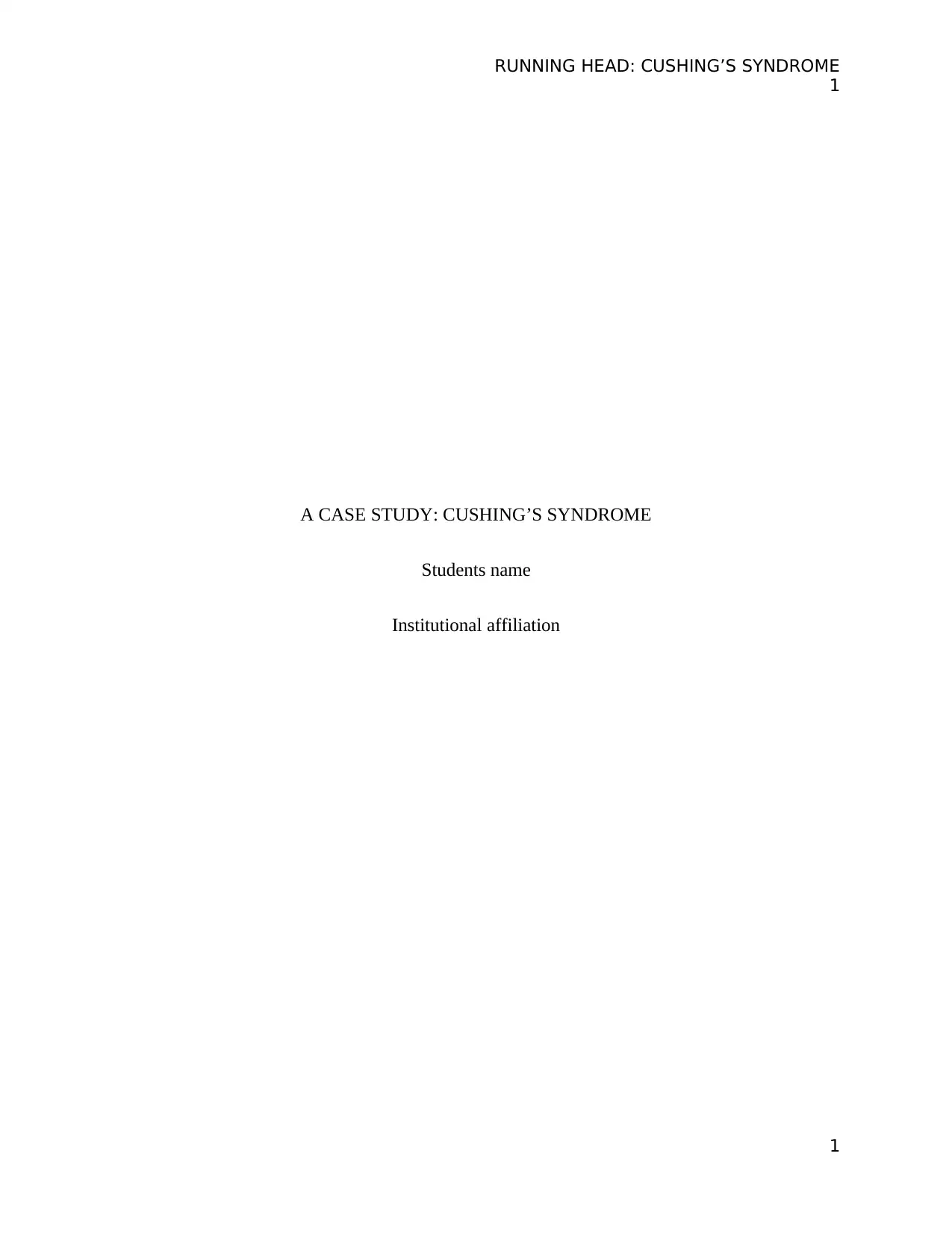
RUNNING HEAD: CUSHING’S SYNDROME
1
A CASE STUDY: CUSHING’S SYNDROME
Students name
Institutional affiliation
1
1
A CASE STUDY: CUSHING’S SYNDROME
Students name
Institutional affiliation
1
Secure Best Marks with AI Grader
Need help grading? Try our AI Grader for instant feedback on your assignments.
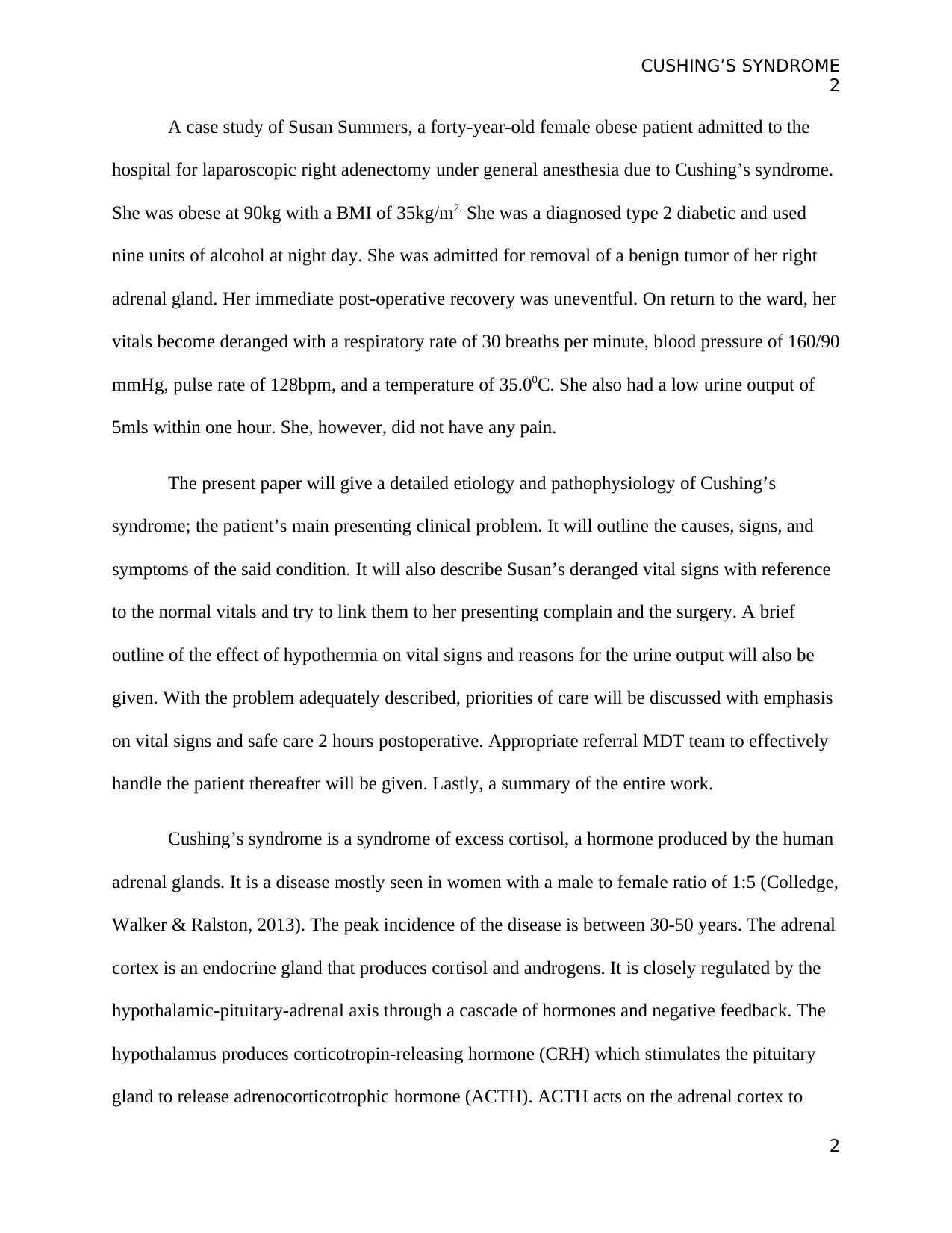
CUSHING’S SYNDROME
2
A case study of Susan Summers, a forty-year-old female obese patient admitted to the
hospital for laparoscopic right adenectomy under general anesthesia due to Cushing’s syndrome.
She was obese at 90kg with a BMI of 35kg/m2. She was a diagnosed type 2 diabetic and used
nine units of alcohol at night day. She was admitted for removal of a benign tumor of her right
adrenal gland. Her immediate post-operative recovery was uneventful. On return to the ward, her
vitals become deranged with a respiratory rate of 30 breaths per minute, blood pressure of 160/90
mmHg, pulse rate of 128bpm, and a temperature of 35.00C. She also had a low urine output of
5mls within one hour. She, however, did not have any pain.
The present paper will give a detailed etiology and pathophysiology of Cushing’s
syndrome; the patient’s main presenting clinical problem. It will outline the causes, signs, and
symptoms of the said condition. It will also describe Susan’s deranged vital signs with reference
to the normal vitals and try to link them to her presenting complain and the surgery. A brief
outline of the effect of hypothermia on vital signs and reasons for the urine output will also be
given. With the problem adequately described, priorities of care will be discussed with emphasis
on vital signs and safe care 2 hours postoperative. Appropriate referral MDT team to effectively
handle the patient thereafter will be given. Lastly, a summary of the entire work.
Cushing’s syndrome is a syndrome of excess cortisol, a hormone produced by the human
adrenal glands. It is a disease mostly seen in women with a male to female ratio of 1:5 (Colledge,
Walker & Ralston, 2013). The peak incidence of the disease is between 30-50 years. The adrenal
cortex is an endocrine gland that produces cortisol and androgens. It is closely regulated by the
hypothalamic-pituitary-adrenal axis through a cascade of hormones and negative feedback. The
hypothalamus produces corticotropin-releasing hormone (CRH) which stimulates the pituitary
gland to release adrenocorticotrophic hormone (ACTH). ACTH acts on the adrenal cortex to
2
2
A case study of Susan Summers, a forty-year-old female obese patient admitted to the
hospital for laparoscopic right adenectomy under general anesthesia due to Cushing’s syndrome.
She was obese at 90kg with a BMI of 35kg/m2. She was a diagnosed type 2 diabetic and used
nine units of alcohol at night day. She was admitted for removal of a benign tumor of her right
adrenal gland. Her immediate post-operative recovery was uneventful. On return to the ward, her
vitals become deranged with a respiratory rate of 30 breaths per minute, blood pressure of 160/90
mmHg, pulse rate of 128bpm, and a temperature of 35.00C. She also had a low urine output of
5mls within one hour. She, however, did not have any pain.
The present paper will give a detailed etiology and pathophysiology of Cushing’s
syndrome; the patient’s main presenting clinical problem. It will outline the causes, signs, and
symptoms of the said condition. It will also describe Susan’s deranged vital signs with reference
to the normal vitals and try to link them to her presenting complain and the surgery. A brief
outline of the effect of hypothermia on vital signs and reasons for the urine output will also be
given. With the problem adequately described, priorities of care will be discussed with emphasis
on vital signs and safe care 2 hours postoperative. Appropriate referral MDT team to effectively
handle the patient thereafter will be given. Lastly, a summary of the entire work.
Cushing’s syndrome is a syndrome of excess cortisol, a hormone produced by the human
adrenal glands. It is a disease mostly seen in women with a male to female ratio of 1:5 (Colledge,
Walker & Ralston, 2013). The peak incidence of the disease is between 30-50 years. The adrenal
cortex is an endocrine gland that produces cortisol and androgens. It is closely regulated by the
hypothalamic-pituitary-adrenal axis through a cascade of hormones and negative feedback. The
hypothalamus produces corticotropin-releasing hormone (CRH) which stimulates the pituitary
gland to release adrenocorticotrophic hormone (ACTH). ACTH acts on the adrenal cortex to
2
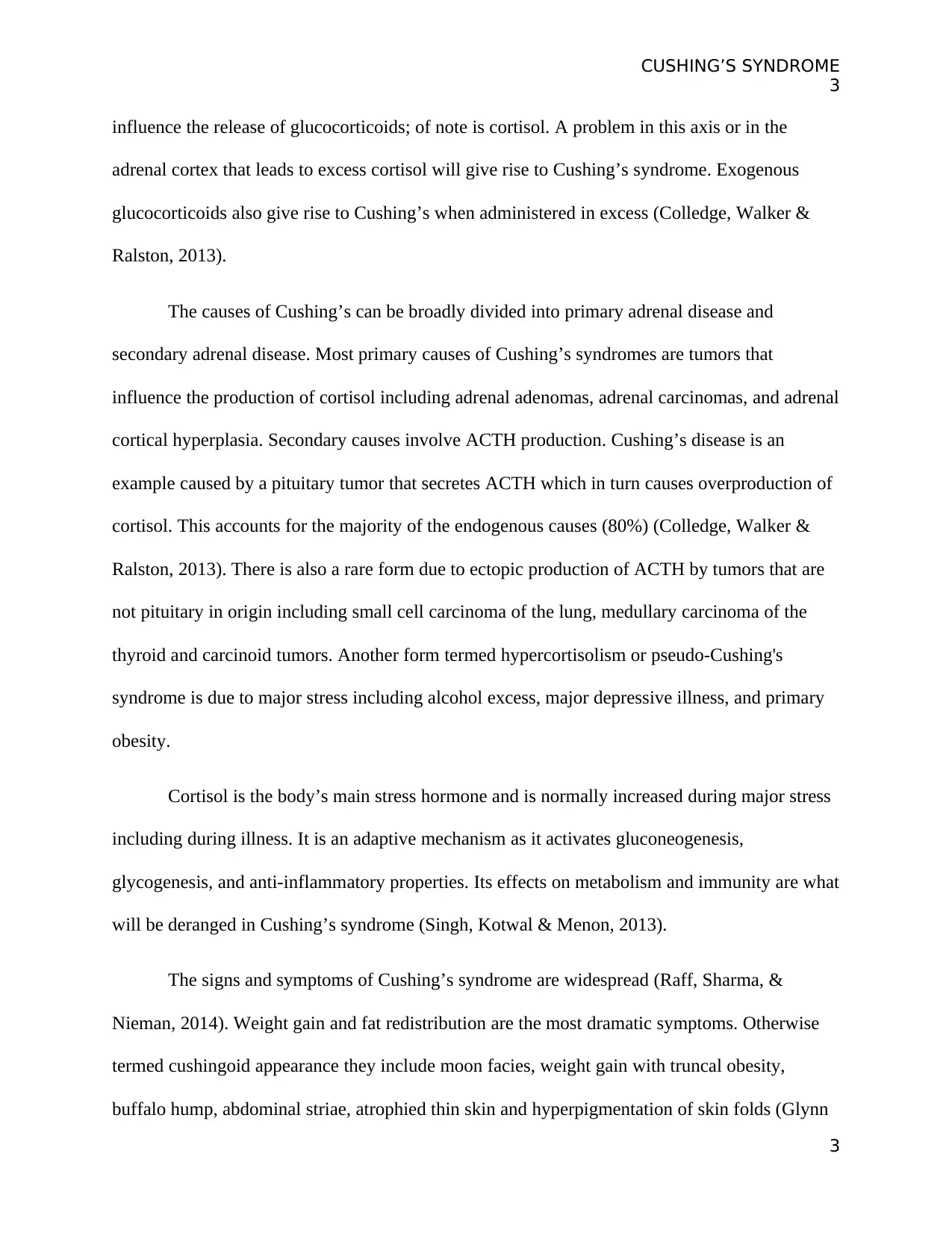
CUSHING’S SYNDROME
3
influence the release of glucocorticoids; of note is cortisol. A problem in this axis or in the
adrenal cortex that leads to excess cortisol will give rise to Cushing’s syndrome. Exogenous
glucocorticoids also give rise to Cushing’s when administered in excess (Colledge, Walker &
Ralston, 2013).
The causes of Cushing’s can be broadly divided into primary adrenal disease and
secondary adrenal disease. Most primary causes of Cushing’s syndromes are tumors that
influence the production of cortisol including adrenal adenomas, adrenal carcinomas, and adrenal
cortical hyperplasia. Secondary causes involve ACTH production. Cushing’s disease is an
example caused by a pituitary tumor that secretes ACTH which in turn causes overproduction of
cortisol. This accounts for the majority of the endogenous causes (80%) (Colledge, Walker &
Ralston, 2013). There is also a rare form due to ectopic production of ACTH by tumors that are
not pituitary in origin including small cell carcinoma of the lung, medullary carcinoma of the
thyroid and carcinoid tumors. Another form termed hypercortisolism or pseudo-Cushing's
syndrome is due to major stress including alcohol excess, major depressive illness, and primary
obesity.
Cortisol is the body’s main stress hormone and is normally increased during major stress
including during illness. It is an adaptive mechanism as it activates gluconeogenesis,
glycogenesis, and anti-inflammatory properties. Its effects on metabolism and immunity are what
will be deranged in Cushing’s syndrome (Singh, Kotwal & Menon, 2013).
The signs and symptoms of Cushing’s syndrome are widespread (Raff, Sharma, &
Nieman, 2014). Weight gain and fat redistribution are the most dramatic symptoms. Otherwise
termed cushingoid appearance they include moon facies, weight gain with truncal obesity,
buffalo hump, abdominal striae, atrophied thin skin and hyperpigmentation of skin folds (Glynn
3
3
influence the release of glucocorticoids; of note is cortisol. A problem in this axis or in the
adrenal cortex that leads to excess cortisol will give rise to Cushing’s syndrome. Exogenous
glucocorticoids also give rise to Cushing’s when administered in excess (Colledge, Walker &
Ralston, 2013).
The causes of Cushing’s can be broadly divided into primary adrenal disease and
secondary adrenal disease. Most primary causes of Cushing’s syndromes are tumors that
influence the production of cortisol including adrenal adenomas, adrenal carcinomas, and adrenal
cortical hyperplasia. Secondary causes involve ACTH production. Cushing’s disease is an
example caused by a pituitary tumor that secretes ACTH which in turn causes overproduction of
cortisol. This accounts for the majority of the endogenous causes (80%) (Colledge, Walker &
Ralston, 2013). There is also a rare form due to ectopic production of ACTH by tumors that are
not pituitary in origin including small cell carcinoma of the lung, medullary carcinoma of the
thyroid and carcinoid tumors. Another form termed hypercortisolism or pseudo-Cushing's
syndrome is due to major stress including alcohol excess, major depressive illness, and primary
obesity.
Cortisol is the body’s main stress hormone and is normally increased during major stress
including during illness. It is an adaptive mechanism as it activates gluconeogenesis,
glycogenesis, and anti-inflammatory properties. Its effects on metabolism and immunity are what
will be deranged in Cushing’s syndrome (Singh, Kotwal & Menon, 2013).
The signs and symptoms of Cushing’s syndrome are widespread (Raff, Sharma, &
Nieman, 2014). Weight gain and fat redistribution are the most dramatic symptoms. Otherwise
termed cushingoid appearance they include moon facies, weight gain with truncal obesity,
buffalo hump, abdominal striae, atrophied thin skin and hyperpigmentation of skin folds (Glynn
3
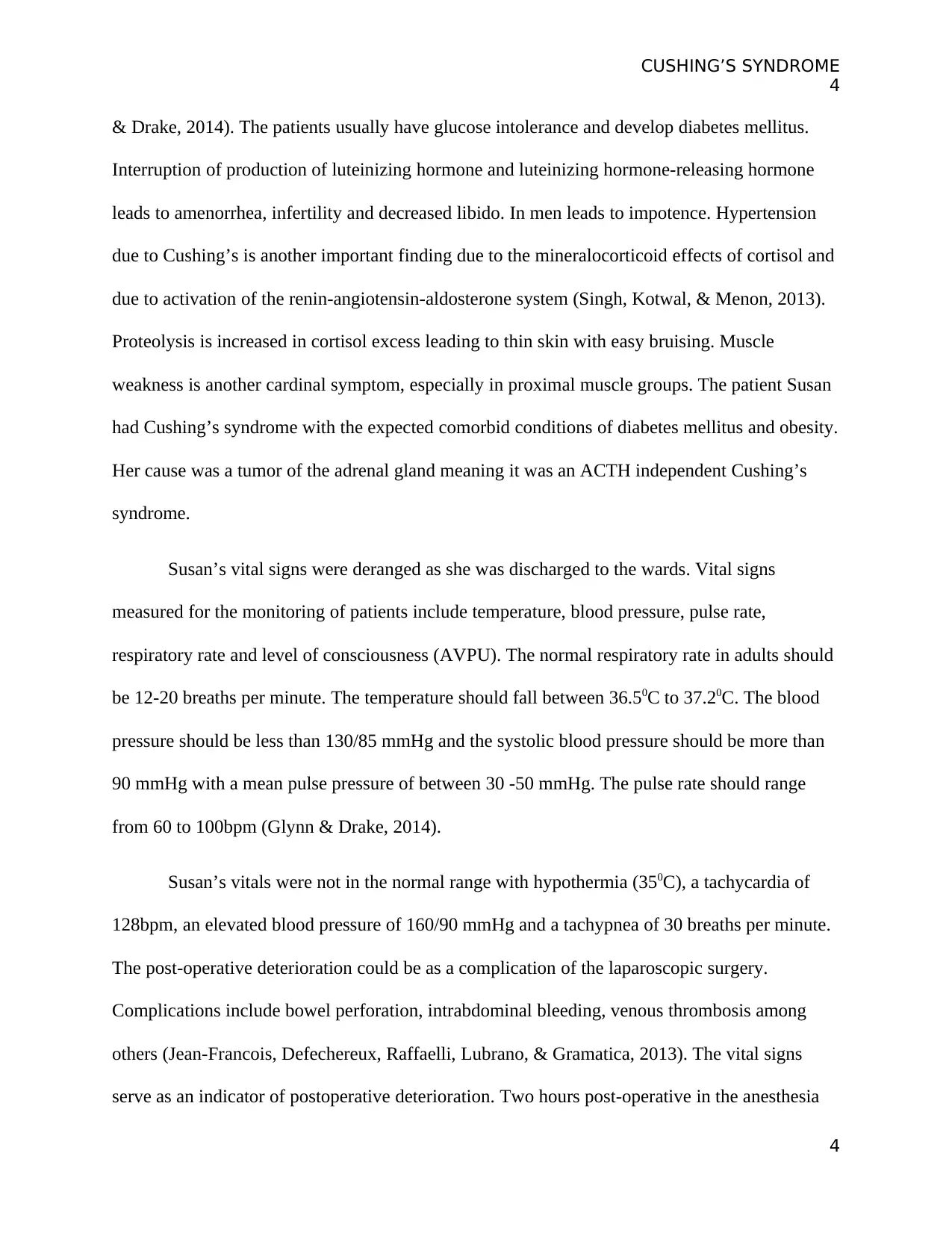
CUSHING’S SYNDROME
4
& Drake, 2014). The patients usually have glucose intolerance and develop diabetes mellitus.
Interruption of production of luteinizing hormone and luteinizing hormone-releasing hormone
leads to amenorrhea, infertility and decreased libido. In men leads to impotence. Hypertension
due to Cushing’s is another important finding due to the mineralocorticoid effects of cortisol and
due to activation of the renin-angiotensin-aldosterone system (Singh, Kotwal, & Menon, 2013).
Proteolysis is increased in cortisol excess leading to thin skin with easy bruising. Muscle
weakness is another cardinal symptom, especially in proximal muscle groups. The patient Susan
had Cushing’s syndrome with the expected comorbid conditions of diabetes mellitus and obesity.
Her cause was a tumor of the adrenal gland meaning it was an ACTH independent Cushing’s
syndrome.
Susan’s vital signs were deranged as she was discharged to the wards. Vital signs
measured for the monitoring of patients include temperature, blood pressure, pulse rate,
respiratory rate and level of consciousness (AVPU). The normal respiratory rate in adults should
be 12-20 breaths per minute. The temperature should fall between 36.50C to 37.20C. The blood
pressure should be less than 130/85 mmHg and the systolic blood pressure should be more than
90 mmHg with a mean pulse pressure of between 30 -50 mmHg. The pulse rate should range
from 60 to 100bpm (Glynn & Drake, 2014).
Susan’s vitals were not in the normal range with hypothermia (350C), a tachycardia of
128bpm, an elevated blood pressure of 160/90 mmHg and a tachypnea of 30 breaths per minute.
The post-operative deterioration could be as a complication of the laparoscopic surgery.
Complications include bowel perforation, intrabdominal bleeding, venous thrombosis among
others (Jean-Francois, Defechereux, Raffaelli, Lubrano, & Gramatica, 2013). The vital signs
serve as an indicator of postoperative deterioration. Two hours post-operative in the anesthesia
4
4
& Drake, 2014). The patients usually have glucose intolerance and develop diabetes mellitus.
Interruption of production of luteinizing hormone and luteinizing hormone-releasing hormone
leads to amenorrhea, infertility and decreased libido. In men leads to impotence. Hypertension
due to Cushing’s is another important finding due to the mineralocorticoid effects of cortisol and
due to activation of the renin-angiotensin-aldosterone system (Singh, Kotwal, & Menon, 2013).
Proteolysis is increased in cortisol excess leading to thin skin with easy bruising. Muscle
weakness is another cardinal symptom, especially in proximal muscle groups. The patient Susan
had Cushing’s syndrome with the expected comorbid conditions of diabetes mellitus and obesity.
Her cause was a tumor of the adrenal gland meaning it was an ACTH independent Cushing’s
syndrome.
Susan’s vital signs were deranged as she was discharged to the wards. Vital signs
measured for the monitoring of patients include temperature, blood pressure, pulse rate,
respiratory rate and level of consciousness (AVPU). The normal respiratory rate in adults should
be 12-20 breaths per minute. The temperature should fall between 36.50C to 37.20C. The blood
pressure should be less than 130/85 mmHg and the systolic blood pressure should be more than
90 mmHg with a mean pulse pressure of between 30 -50 mmHg. The pulse rate should range
from 60 to 100bpm (Glynn & Drake, 2014).
Susan’s vitals were not in the normal range with hypothermia (350C), a tachycardia of
128bpm, an elevated blood pressure of 160/90 mmHg and a tachypnea of 30 breaths per minute.
The post-operative deterioration could be as a complication of the laparoscopic surgery.
Complications include bowel perforation, intrabdominal bleeding, venous thrombosis among
others (Jean-Francois, Defechereux, Raffaelli, Lubrano, & Gramatica, 2013). The vital signs
serve as an indicator of postoperative deterioration. Two hours post-operative in the anesthesia
4
Secure Best Marks with AI Grader
Need help grading? Try our AI Grader for instant feedback on your assignments.
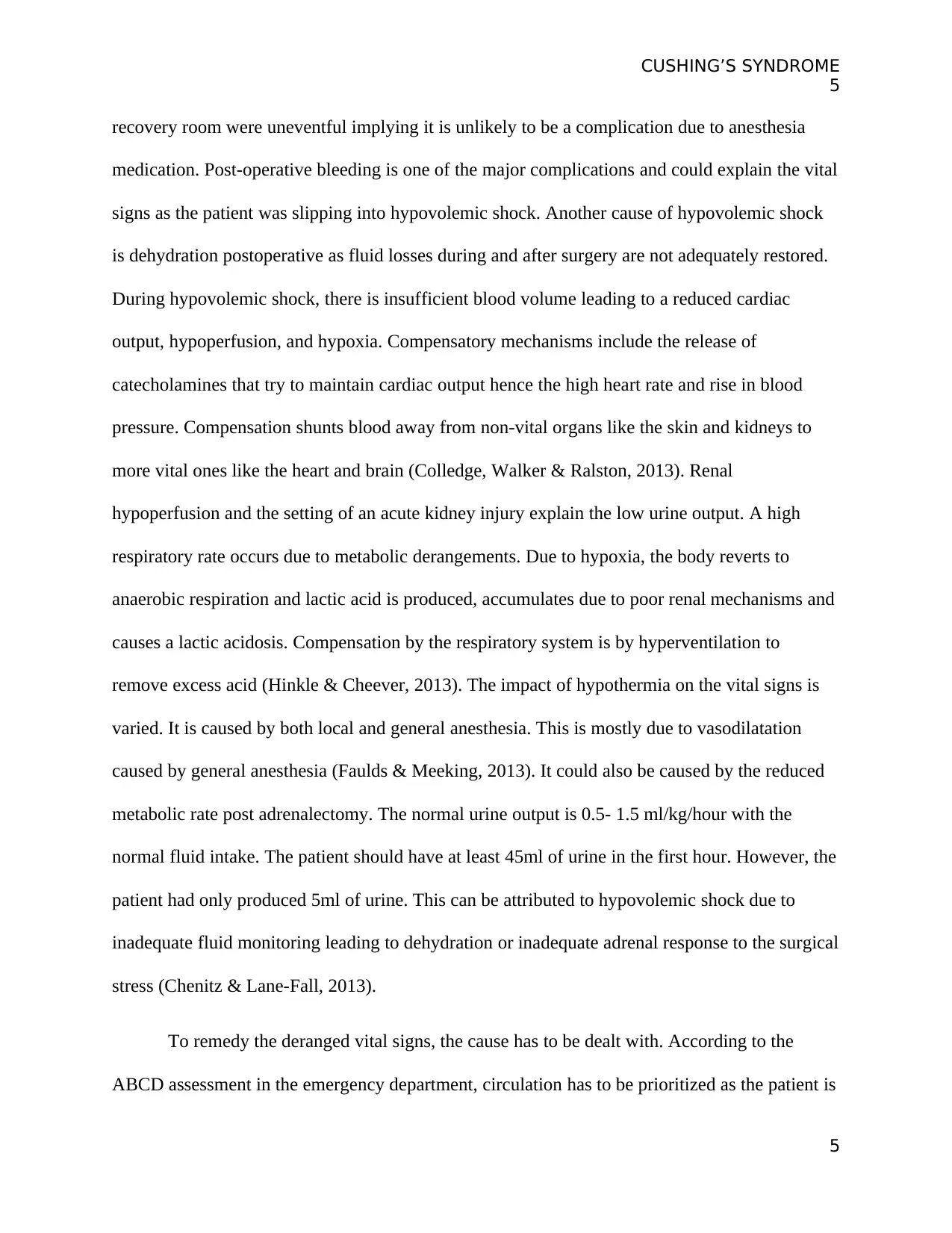
CUSHING’S SYNDROME
5
recovery room were uneventful implying it is unlikely to be a complication due to anesthesia
medication. Post-operative bleeding is one of the major complications and could explain the vital
signs as the patient was slipping into hypovolemic shock. Another cause of hypovolemic shock
is dehydration postoperative as fluid losses during and after surgery are not adequately restored.
During hypovolemic shock, there is insufficient blood volume leading to a reduced cardiac
output, hypoperfusion, and hypoxia. Compensatory mechanisms include the release of
catecholamines that try to maintain cardiac output hence the high heart rate and rise in blood
pressure. Compensation shunts blood away from non-vital organs like the skin and kidneys to
more vital ones like the heart and brain (Colledge, Walker & Ralston, 2013). Renal
hypoperfusion and the setting of an acute kidney injury explain the low urine output. A high
respiratory rate occurs due to metabolic derangements. Due to hypoxia, the body reverts to
anaerobic respiration and lactic acid is produced, accumulates due to poor renal mechanisms and
causes a lactic acidosis. Compensation by the respiratory system is by hyperventilation to
remove excess acid (Hinkle & Cheever, 2013). The impact of hypothermia on the vital signs is
varied. It is caused by both local and general anesthesia. This is mostly due to vasodilatation
caused by general anesthesia (Faulds & Meeking, 2013). It could also be caused by the reduced
metabolic rate post adrenalectomy. The normal urine output is 0.5- 1.5 ml/kg/hour with the
normal fluid intake. The patient should have at least 45ml of urine in the first hour. However, the
patient had only produced 5ml of urine. This can be attributed to hypovolemic shock due to
inadequate fluid monitoring leading to dehydration or inadequate adrenal response to the surgical
stress (Chenitz & Lane-Fall, 2013).
To remedy the deranged vital signs, the cause has to be dealt with. According to the
ABCD assessment in the emergency department, circulation has to be prioritized as the patient is
5
5
recovery room were uneventful implying it is unlikely to be a complication due to anesthesia
medication. Post-operative bleeding is one of the major complications and could explain the vital
signs as the patient was slipping into hypovolemic shock. Another cause of hypovolemic shock
is dehydration postoperative as fluid losses during and after surgery are not adequately restored.
During hypovolemic shock, there is insufficient blood volume leading to a reduced cardiac
output, hypoperfusion, and hypoxia. Compensatory mechanisms include the release of
catecholamines that try to maintain cardiac output hence the high heart rate and rise in blood
pressure. Compensation shunts blood away from non-vital organs like the skin and kidneys to
more vital ones like the heart and brain (Colledge, Walker & Ralston, 2013). Renal
hypoperfusion and the setting of an acute kidney injury explain the low urine output. A high
respiratory rate occurs due to metabolic derangements. Due to hypoxia, the body reverts to
anaerobic respiration and lactic acid is produced, accumulates due to poor renal mechanisms and
causes a lactic acidosis. Compensation by the respiratory system is by hyperventilation to
remove excess acid (Hinkle & Cheever, 2013). The impact of hypothermia on the vital signs is
varied. It is caused by both local and general anesthesia. This is mostly due to vasodilatation
caused by general anesthesia (Faulds & Meeking, 2013). It could also be caused by the reduced
metabolic rate post adrenalectomy. The normal urine output is 0.5- 1.5 ml/kg/hour with the
normal fluid intake. The patient should have at least 45ml of urine in the first hour. However, the
patient had only produced 5ml of urine. This can be attributed to hypovolemic shock due to
inadequate fluid monitoring leading to dehydration or inadequate adrenal response to the surgical
stress (Chenitz & Lane-Fall, 2013).
To remedy the deranged vital signs, the cause has to be dealt with. According to the
ABCD assessment in the emergency department, circulation has to be prioritized as the patient is
5
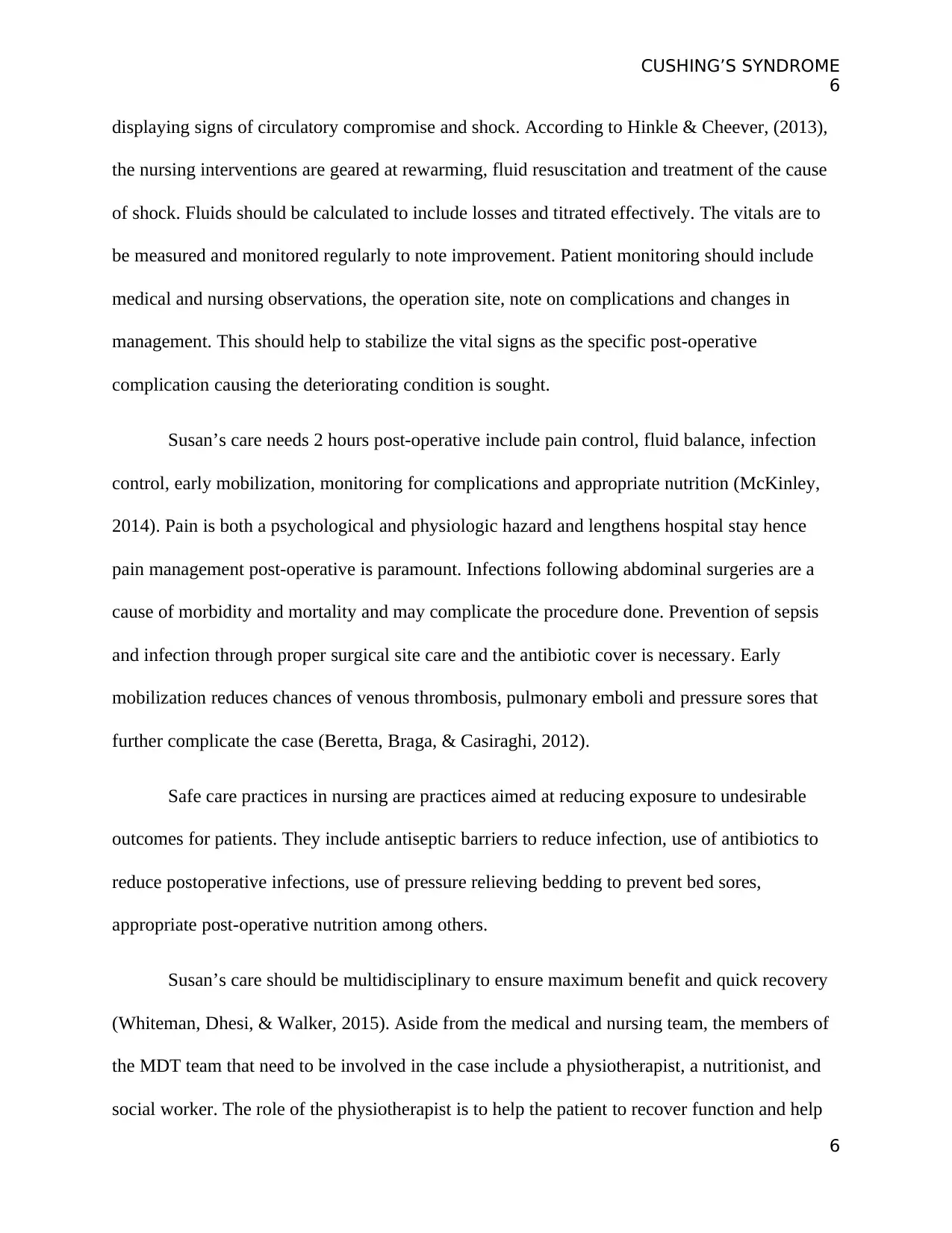
CUSHING’S SYNDROME
6
displaying signs of circulatory compromise and shock. According to Hinkle & Cheever, (2013),
the nursing interventions are geared at rewarming, fluid resuscitation and treatment of the cause
of shock. Fluids should be calculated to include losses and titrated effectively. The vitals are to
be measured and monitored regularly to note improvement. Patient monitoring should include
medical and nursing observations, the operation site, note on complications and changes in
management. This should help to stabilize the vital signs as the specific post-operative
complication causing the deteriorating condition is sought.
Susan’s care needs 2 hours post-operative include pain control, fluid balance, infection
control, early mobilization, monitoring for complications and appropriate nutrition (McKinley,
2014). Pain is both a psychological and physiologic hazard and lengthens hospital stay hence
pain management post-operative is paramount. Infections following abdominal surgeries are a
cause of morbidity and mortality and may complicate the procedure done. Prevention of sepsis
and infection through proper surgical site care and the antibiotic cover is necessary. Early
mobilization reduces chances of venous thrombosis, pulmonary emboli and pressure sores that
further complicate the case (Beretta, Braga, & Casiraghi, 2012).
Safe care practices in nursing are practices aimed at reducing exposure to undesirable
outcomes for patients. They include antiseptic barriers to reduce infection, use of antibiotics to
reduce postoperative infections, use of pressure relieving bedding to prevent bed sores,
appropriate post-operative nutrition among others.
Susan’s care should be multidisciplinary to ensure maximum benefit and quick recovery
(Whiteman, Dhesi, & Walker, 2015). Aside from the medical and nursing team, the members of
the MDT team that need to be involved in the case include a physiotherapist, a nutritionist, and
social worker. The role of the physiotherapist is to help the patient to recover function and help
6
6
displaying signs of circulatory compromise and shock. According to Hinkle & Cheever, (2013),
the nursing interventions are geared at rewarming, fluid resuscitation and treatment of the cause
of shock. Fluids should be calculated to include losses and titrated effectively. The vitals are to
be measured and monitored regularly to note improvement. Patient monitoring should include
medical and nursing observations, the operation site, note on complications and changes in
management. This should help to stabilize the vital signs as the specific post-operative
complication causing the deteriorating condition is sought.
Susan’s care needs 2 hours post-operative include pain control, fluid balance, infection
control, early mobilization, monitoring for complications and appropriate nutrition (McKinley,
2014). Pain is both a psychological and physiologic hazard and lengthens hospital stay hence
pain management post-operative is paramount. Infections following abdominal surgeries are a
cause of morbidity and mortality and may complicate the procedure done. Prevention of sepsis
and infection through proper surgical site care and the antibiotic cover is necessary. Early
mobilization reduces chances of venous thrombosis, pulmonary emboli and pressure sores that
further complicate the case (Beretta, Braga, & Casiraghi, 2012).
Safe care practices in nursing are practices aimed at reducing exposure to undesirable
outcomes for patients. They include antiseptic barriers to reduce infection, use of antibiotics to
reduce postoperative infections, use of pressure relieving bedding to prevent bed sores,
appropriate post-operative nutrition among others.
Susan’s care should be multidisciplinary to ensure maximum benefit and quick recovery
(Whiteman, Dhesi, & Walker, 2015). Aside from the medical and nursing team, the members of
the MDT team that need to be involved in the case include a physiotherapist, a nutritionist, and
social worker. The role of the physiotherapist is to help the patient to recover function and help
6
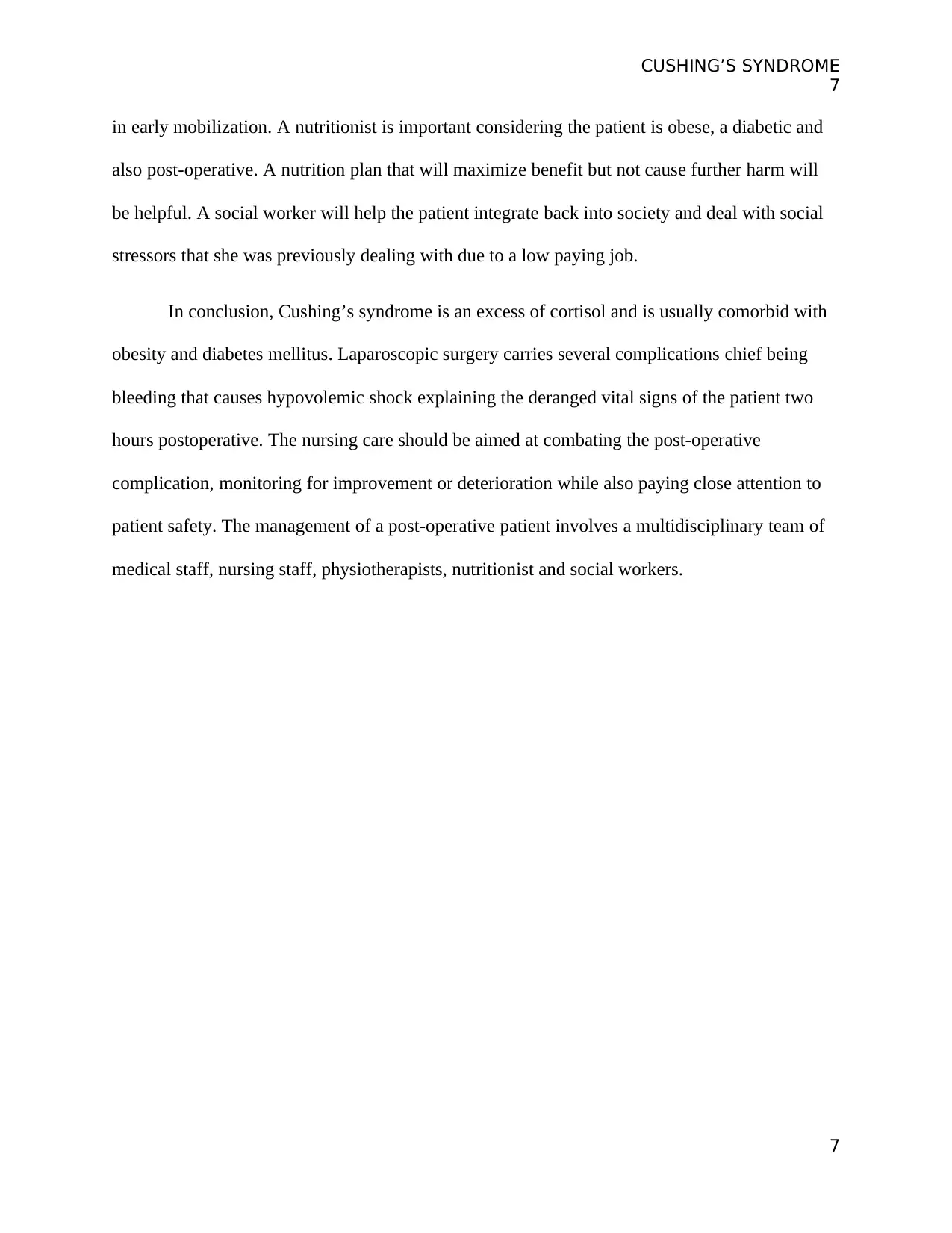
CUSHING’S SYNDROME
7
in early mobilization. A nutritionist is important considering the patient is obese, a diabetic and
also post-operative. A nutrition plan that will maximize benefit but not cause further harm will
be helpful. A social worker will help the patient integrate back into society and deal with social
stressors that she was previously dealing with due to a low paying job.
In conclusion, Cushing’s syndrome is an excess of cortisol and is usually comorbid with
obesity and diabetes mellitus. Laparoscopic surgery carries several complications chief being
bleeding that causes hypovolemic shock explaining the deranged vital signs of the patient two
hours postoperative. The nursing care should be aimed at combating the post-operative
complication, monitoring for improvement or deterioration while also paying close attention to
patient safety. The management of a post-operative patient involves a multidisciplinary team of
medical staff, nursing staff, physiotherapists, nutritionist and social workers.
7
7
in early mobilization. A nutritionist is important considering the patient is obese, a diabetic and
also post-operative. A nutrition plan that will maximize benefit but not cause further harm will
be helpful. A social worker will help the patient integrate back into society and deal with social
stressors that she was previously dealing with due to a low paying job.
In conclusion, Cushing’s syndrome is an excess of cortisol and is usually comorbid with
obesity and diabetes mellitus. Laparoscopic surgery carries several complications chief being
bleeding that causes hypovolemic shock explaining the deranged vital signs of the patient two
hours postoperative. The nursing care should be aimed at combating the post-operative
complication, monitoring for improvement or deterioration while also paying close attention to
patient safety. The management of a post-operative patient involves a multidisciplinary team of
medical staff, nursing staff, physiotherapists, nutritionist and social workers.
7
Paraphrase This Document
Need a fresh take? Get an instant paraphrase of this document with our AI Paraphraser
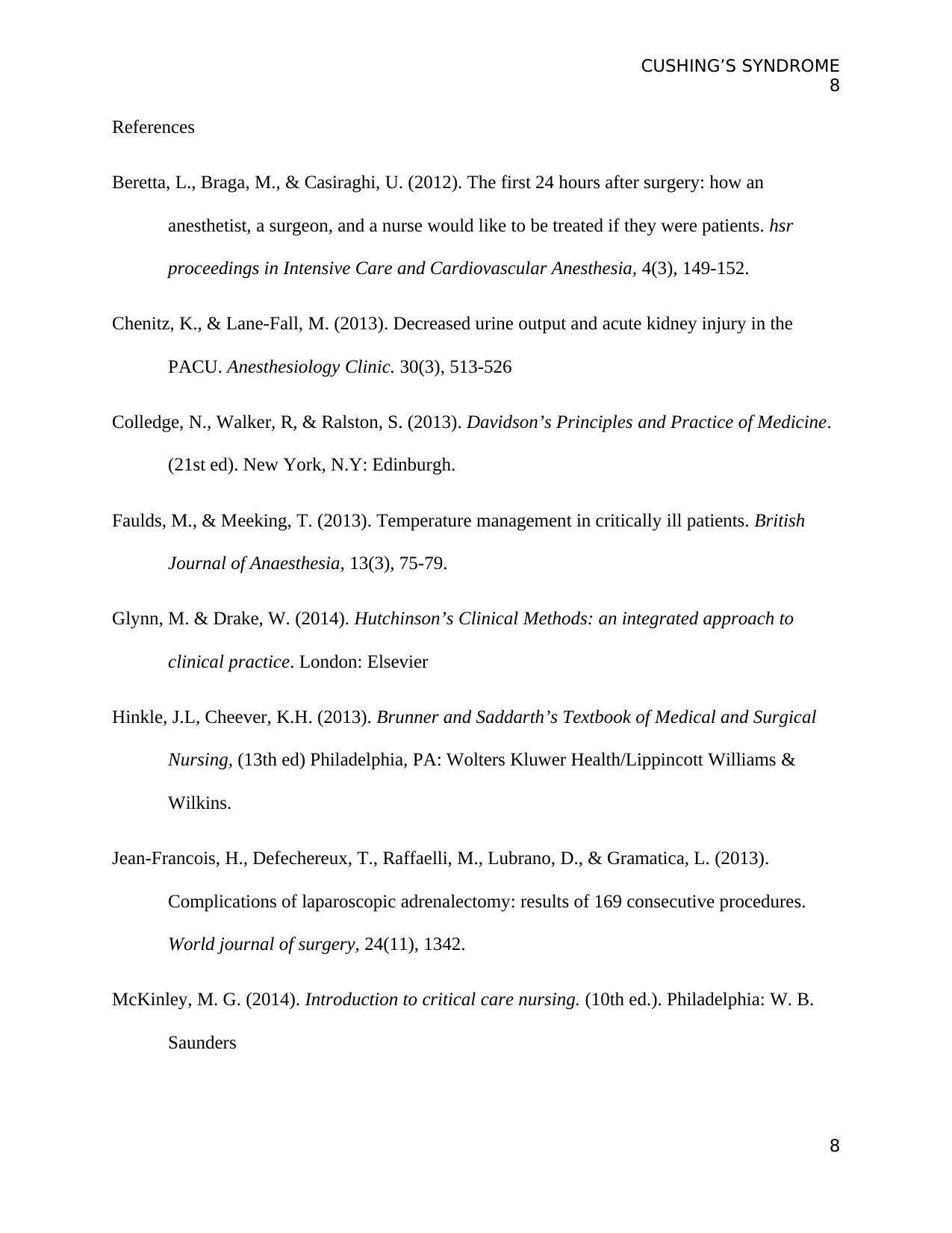
CUSHING’S SYNDROME
8
References
Beretta, L., Braga, M., & Casiraghi, U. (2012). The first 24 hours after surgery: how an
anesthetist, a surgeon, and a nurse would like to be treated if they were patients. hsr
proceedings in Intensive Care and Cardiovascular Anesthesia, 4(3), 149-152.
Chenitz, K., & Lane-Fall, M. (2013). Decreased urine output and acute kidney injury in the
PACU. Anesthesiology Clinic. 30(3), 513-526
Colledge, N., Walker, R, & Ralston, S. (2013). Davidson’s Principles and Practice of Medicine.
(21st ed). New York, N.Y: Edinburgh.
Faulds, M., & Meeking, T. (2013). Temperature management in critically ill patients. British
Journal of Anaesthesia, 13(3), 75-79.
Glynn, M. & Drake, W. (2014). Hutchinson’s Clinical Methods: an integrated approach to
clinical practice. London: Elsevier
Hinkle, J.L, Cheever, K.H. (2013). Brunner and Saddarth’s Textbook of Medical and Surgical
Nursing, (13th ed) Philadelphia, PA: Wolters Kluwer Health/Lippincott Williams &
Wilkins.
Jean-Francois, H., Defechereux, T., Raffaelli, M., Lubrano, D., & Gramatica, L. (2013).
Complications of laparoscopic adrenalectomy: results of 169 consecutive procedures.
World journal of surgery, 24(11), 1342.
McKinley, M. G. (2014). Introduction to critical care nursing. (10th ed.). Philadelphia: W. B.
Saunders
8
8
References
Beretta, L., Braga, M., & Casiraghi, U. (2012). The first 24 hours after surgery: how an
anesthetist, a surgeon, and a nurse would like to be treated if they were patients. hsr
proceedings in Intensive Care and Cardiovascular Anesthesia, 4(3), 149-152.
Chenitz, K., & Lane-Fall, M. (2013). Decreased urine output and acute kidney injury in the
PACU. Anesthesiology Clinic. 30(3), 513-526
Colledge, N., Walker, R, & Ralston, S. (2013). Davidson’s Principles and Practice of Medicine.
(21st ed). New York, N.Y: Edinburgh.
Faulds, M., & Meeking, T. (2013). Temperature management in critically ill patients. British
Journal of Anaesthesia, 13(3), 75-79.
Glynn, M. & Drake, W. (2014). Hutchinson’s Clinical Methods: an integrated approach to
clinical practice. London: Elsevier
Hinkle, J.L, Cheever, K.H. (2013). Brunner and Saddarth’s Textbook of Medical and Surgical
Nursing, (13th ed) Philadelphia, PA: Wolters Kluwer Health/Lippincott Williams &
Wilkins.
Jean-Francois, H., Defechereux, T., Raffaelli, M., Lubrano, D., & Gramatica, L. (2013).
Complications of laparoscopic adrenalectomy: results of 169 consecutive procedures.
World journal of surgery, 24(11), 1342.
McKinley, M. G. (2014). Introduction to critical care nursing. (10th ed.). Philadelphia: W. B.
Saunders
8
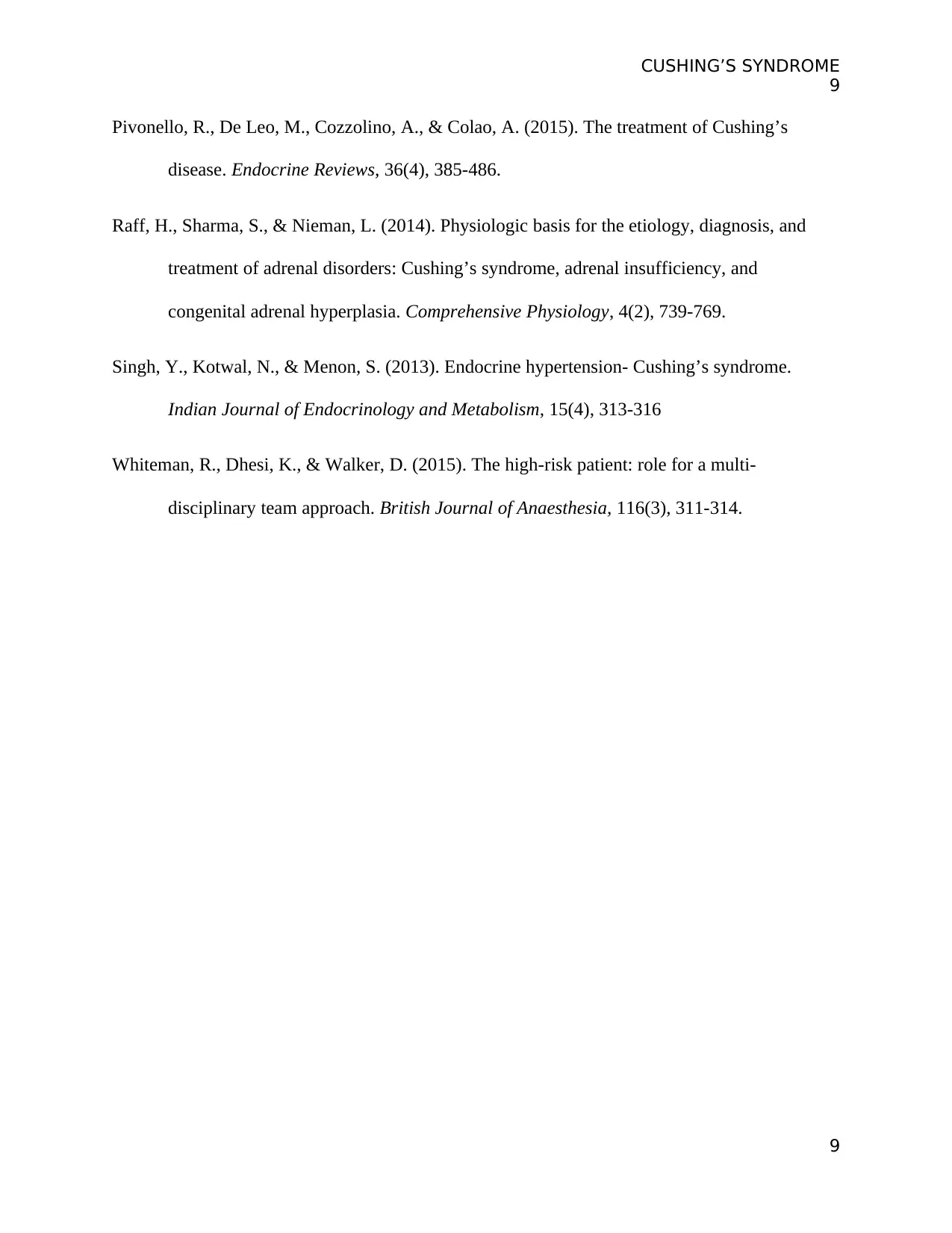
CUSHING’S SYNDROME
9
Pivonello, R., De Leo, M., Cozzolino, A., & Colao, A. (2015). The treatment of Cushing’s
disease. Endocrine Reviews, 36(4), 385-486.
Raff, H., Sharma, S., & Nieman, L. (2014). Physiologic basis for the etiology, diagnosis, and
treatment of adrenal disorders: Cushing’s syndrome, adrenal insufficiency, and
congenital adrenal hyperplasia. Comprehensive Physiology, 4(2), 739-769.
Singh, Y., Kotwal, N., & Menon, S. (2013). Endocrine hypertension- Cushing’s syndrome.
Indian Journal of Endocrinology and Metabolism, 15(4), 313-316
Whiteman, R., Dhesi, K., & Walker, D. (2015). The high-risk patient: role for a multi-
disciplinary team approach. British Journal of Anaesthesia, 116(3), 311-314.
9
9
Pivonello, R., De Leo, M., Cozzolino, A., & Colao, A. (2015). The treatment of Cushing’s
disease. Endocrine Reviews, 36(4), 385-486.
Raff, H., Sharma, S., & Nieman, L. (2014). Physiologic basis for the etiology, diagnosis, and
treatment of adrenal disorders: Cushing’s syndrome, adrenal insufficiency, and
congenital adrenal hyperplasia. Comprehensive Physiology, 4(2), 739-769.
Singh, Y., Kotwal, N., & Menon, S. (2013). Endocrine hypertension- Cushing’s syndrome.
Indian Journal of Endocrinology and Metabolism, 15(4), 313-316
Whiteman, R., Dhesi, K., & Walker, D. (2015). The high-risk patient: role for a multi-
disciplinary team approach. British Journal of Anaesthesia, 116(3), 311-314.
9
1 out of 9
Related Documents
Your All-in-One AI-Powered Toolkit for Academic Success.
+13062052269
info@desklib.com
Available 24*7 on WhatsApp / Email
![[object Object]](/_next/static/media/star-bottom.7253800d.svg)
Unlock your academic potential
© 2024 | Zucol Services PVT LTD | All rights reserved.





